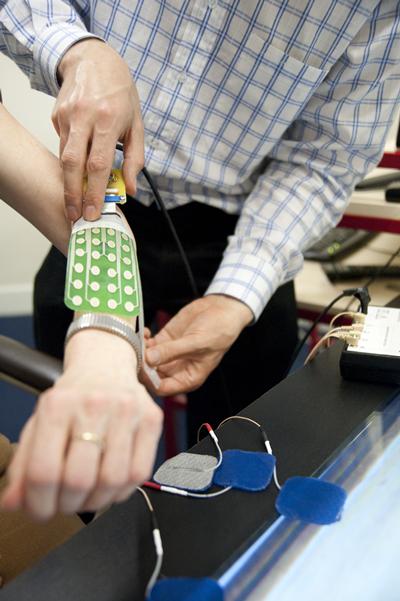Jane Helena Burridge, MCSP, LGSM, PhD, Professor of Restorative Neuroscience. Health Sciences, University of Southampton E-Mail jhb1@soton.ac.uk
1973-1993 Basic grade and then Senior I Physiotherapist specialising in stroke rehabilitation
1978 - 1990 Raise a family, study music and practice as music teacher and freelance musician
1/93 - 1/99 Senior I / clinical specialist, research physiotherapist, Salisbury District Hospital
12/99 –1/03 Senior Lecturer, Head of Postgraduate Education SOHPRS University of Southampton
1/03 – 9/08 Senior Research Fellow / Senior Lecturer, SOHPRS, University of Southampton
09/08 Professor of Restorative Neuroscience FOHS, University of Southampton
I am Professor of Restorative Neuroscience at the University of Southampton, where I lead the Neurorehabilitation Research Group and Chair the University of Southampton Strategic Research group ‘Health Technology’. I graduated as a physiotherapist from Bristol in the UK in 1973 and after working as a physical therapist for four years, changed career and trained as a musician at the Guildhall School of Music and Drama in London. I developed a career as a performer and teacher of the flute and raised a family. In 1993 I began my PhD study at the University of Southampton and graduated in 1999. My research enabled response to Functional Electrical Stimulation for drop-foot to be better predicted by accurate measurement of muscle dysfunction. In 1999 I took up a senior lectureship at the University of Southampton as Head of Postgraduate Education with the remit to design and validate a multi-disciplinary MSc in Rehabilitation.
In 2008 I was appointed to my current position as Chair of Restorative Neuroscience. Building on my experience as a clinical physiotherapist specialising stroke, the aim of my work has been to understand the mechanisms of recovery post-stroke and how this knowledge can be translated into evidence-based and cost-effective therapy. My research has therefore been into the development, evaluation and clinical application of novel rehabilitation technologies, informed by a better understanding of motor control, neuroplasticity and psychosocial factors. Most of my research is cross-disciplinary involving collaboration with the disciplines of: electronics & computer science, signal processing and health psychology.
Between 2009 and 2013, funded by a UK National Institute of Health Research (NIHR) Programme grant, I explored the barriers to and opportunities for rehabilitation technologies in upper limb rehabilitation following stroke. We identified key factors such as lack of education and awareness (of both healthcare professionals and patients and carers) into rehabilitation technologies, paucity of evidence-based research and NHS funding systems that inhibit the introduction of new technological approaches to stroke rehabilitation.
My work is funded mainly by the UK NIHR and Engineering and Physical Science Research Council (EPSRC), the EU FP7 and medical charities. It has focused on developing home-based rehabilitation technologies, combining robot therapy with Functional Electrical Stimulation (FES) using Iterative Learning Control, and with non-invasive brain stimulation using transcranial direct current stimulation in the treatment of post-stroke hemiplegia. My work also includes measurement of changes in EEG activity (synchronisation and de-synchronisation) in healthy people and in stroke rehabilitation using robot therapy. Working with signal processing engineers, we are developing novel ways to measure and analyse motor control and spasticity and how impairments relate to function in older people and patients with stroke. In collaboration with Health Psychologists we are interested in motivation and adherence in neurological rehabilitation and barriers to adoption of new technologies.
In collaboration with Health Psychologists I have conducted research, funded mainly by the NIHR Research for Patient Benefit (RfPB) (2011-2014) into ways in which patients can be motivated to adhere to their stroke rehabilitation programme. Based on one of the few technologies that has strong research evidence, Constraint Induced Movement Therapy (CIMT), but which has not translated in clinical practice we developed a web-based support programme to enable patients to use CIMT at home without additional therapist input.
Most recently (Nov 2015) I was awarded an NIHR Invention for Innovation (i4i) grant to develop a new technology combining mechanomyography and inertial sensors into a garment to provide feedback to patients and therapists on amount and quality of upper extremity movement following stroke. This work involves collaboration with Imperial College London, two NHS Trusts and two UK companies.
I regularly review proposals and projects for EU FP7 and (H2020), Future and Emerging Technologies, including Neurobotics and currently the NEBIAS project, Wellcome Trust, NIHR and EPSRC. I was President of the International Functional Electrical Stimulation Society from 2011- 2014 and am currently a member of the Editorial board of the Journal of Neurorehabilitation and Neural Repair, and the International Journal of Research in Rehabilitation. I am frequently invited to speak at major International conferences and summer schools e.g. UK Stroke Forum, World Conference of Neurorehabilitation and US STEP VI. for more information visit IV STEP 2016 website.
I am a Consultant for International rehabilitation technology companies including: Bioness and MindMaze and member of the Scientific Board of Directors, Hocoma A/C Zurich.
PhD supervision: I have Supervised 10 PhD students to completion and am currently supervising 8 students, three of whom are International. I have examined more than 14 PhD students including students from Europe and New Zealand.
Education: I teach at Undergraduate and Masters level and co-led an EU Life-Long Learning project (€450k) to develop an MSc in Advanced Rehabilitation Technologies (MSc ART), which involved four European awarding partners and five Associate partners.
Current / Recent Research Grants:
- 2015-2017: PI: NIHR i4i: Mechanical Muscle Activity with Real-time Kinematics (M-MARK): A novel combination of existing technologies to improve arm recovery following stroke (£861k)
- 2013- 2016: PI: Donaldson, Gall, Roberts. INSPIRE Hospital and home-based feasibility study of an iCycle for functional recovery after incomplete spinal cord injury (£38.057) Plus externally funded PhD studentship
- 2011–2015: PI: NIHR RfPB: Development and pilot evaluation of a web-supported programme of Constraint Induced Therapy following stroke (LifeCIT) (£249,634)
- 2012-2015: CI EU FP7 ICT Telemedicine System Empowering Stroke Patients to Fight Back StrokeBack (€3.03M)
- 2011–2014: CI: Rogers, Freeman. EPSRC Restoration of Reach and Grasp in Stroke Patients using Electrical Stimulation and Haptic Feedback EP/I01909X/1 (£464,231) [0.2FTE]
- 2011-2014: CI: MRC/NIHR Efficacy and Mechanism Evaluation programme grant. “Clinical efficacy of functional strength training for upper limb motor recovery early after stroke: neural correlates and prognostic indicators”. (PI: Pomeroy, Co-applicants: Ward, Johansen-Berg, van Vilet, Burridge, Hunter, Lemon, Rothwell, Weir, Norrie, Wing, Barton), £1.2 million
- 2011-2014: PI: Wessex Medical Trust: Combining transcranial Direct current stimulation (tDCS) with robot hand training for the severely impaired hand after stroke (£19,223) Plus externally funded PhD studentship
- 2009-2013: Co-applicant NIHR Programme Grant: Development of an integrated service model incorporating innovative technology for the rehabilitation of the upper limb following stroke (NIHR RP-PG-0707-10012) (£1.9M)

